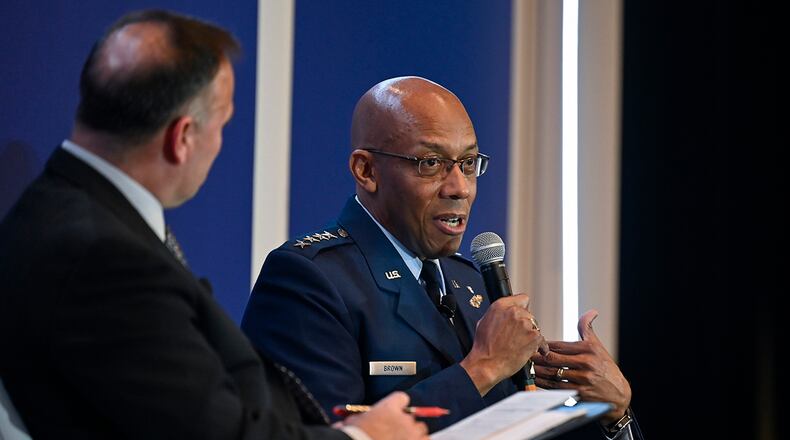Air Force Chief of Staff Gen. CQ Brown Jr., was a keynote speaker at the summit, where he discussed the importance of collaboration between stakeholders.
“One of the things I did when I came in was write Accelerate Change or Lose. There was a key word I put in there, and I put it in for a purpose — collaboration. The things we do, we cannot do by ourselves,” Brown said.
Recent examples of how Air Force and community leaders, with support from Congress, identified opportunities to modify installations to better align with the Air Force’s future design include preparations for the bed down of four new missions at Robins Air Force Base, Georgia, as the Air Force begins to divest Joint Surveillance Target Attack Radar Systems, and approval for construction and renovation projects at Grand Forks Air Force Base, North Dakota, to enable the wing to develop and train crews in support of future intelligence, surveillance and reconnaissance missions.
Brown explained that while challenges vary from location to location, the Air Force welcomes opportunities to enhance mission readiness and increase the quality of life for Airmen and families through partnerships with local communities.
Fairchild AFB, Washington, for example, signed a 10-year intergovernmental support agreement with Spokane to establish a joint-use, small-arms range and tactical training facility, while Altus AFB, Oklahoma, partnered with the city there to enable rezoning and a public-private housing solution just outside of the base to resolve a critical housing issue.
Brown also stressed the need for predictable funding to ensure a successful infrastructure strategy and action plans.
When asked how Congress can assist the Air Force in achieving its infrastructure strategy, Brown responded, “Give us a budget.”
“Continuing resolutions are bad,” he continued. “In the past decade, we’ve only delivered one budget on time. It’s been three years over the past 10 years we’ve been in continuing resolutions. We’re trying to accelerate change. When we cannot move forward and do things, we lose the trust and confidence of our Airmen and their families and our industry partners.”
Brown also discussed the need to create resilient installations to overcome future challenges arising from conflict and climate-related disasters, noting Tyndall AFB, Florida, is the primary testing ground for Department of the Air Force Installations of the Future.
Edwin Oshiba, acting assistant secretary of the Air Force for Energy, Installations, and Environment, who also spoke at the summit, likewise noted Air Force’s efforts to develop adaptation strategies for existing infrastructure and increase the resiliency of newly built infrastructure to account for climate changes.
Credit: Eric R. Dietrich
Credit: Eric R. Dietrich
“In the face of a changing climate, the mission does not change: To fight and win the nation’s wars,” Oshiba said. “The DAF’s priority is to enhance our capabilities and increase resiliency, which have the added benefit of reducing our climate footprint.”
Sharene Brown, spouse of Air Force Chief of Staff Gen. CQ Brown Jr., also spoke at the event to highlight the top-five, quality-of-life issues facing military families and how communities can assist.
She explained “Five and Thrive” aims to improve the quality of life for our military families in five focus areas: childcare, education, healthcare, housing and spouse employment. By highlighting preventative measures, promoting best practices, and fostering community partnerships in these five areas, we want to provide our military families with the best opportunities to thrive.
Just as civilian communities want access, availability, and affordability of the best for their families, so too do military families. Mrs. Brown mentioned a few best practices of partnerships formed between local communities and base installations that are currently serving the needs of military families. In education, Malmstrom AFB, Montana, recently partnered with their local community to create a pilot pre-K program, Career Development Course Intern Program, and will also be hosting an Educator’s Summit to better tackle challenges in education for our military children.
In Northern California, a community partnership provides childcare subsidies to offset the cost for childcare in that area.
Mrs. Brown also highlighted the Thrive Spouse Guide that was created by spouses, for spouses, to help navigate the military way of life and can be found on the Five and Thrive website (www.fiveandthrive.org).
Brown and his wife both thanked community members in attendance for their continued support to Airmen and their families.
About the Author

